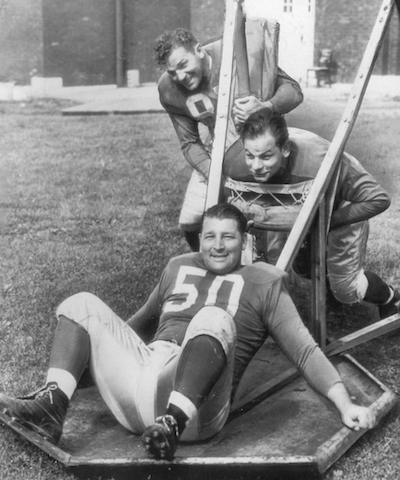
Sport: Football
Born: August 12, 1915
Died: July 13, 1992
Town: South River, New Jersey
Alexander Francis Wojciechowicz was born August 12, 1915 in South River. Alex was intensely competitive as a boy and, being a bit larger than the other kids in his neighborhood, he didn’t shy away from physical contact. He eventually grew to 5’11” and weighed close to 200 pounds at South River High School, where he was a member of the varsity football, baseball and basketball teams. As a senior in the fall of 1933, Alex was named All-State in football. Among his teammates on all three school teams was Pete Stivess, who pitched briefly for the Phillies and then ran a Cold War program for Soviet Bloc defectors in the 1950s and ’60s.
Fordham University was a football powerhouse in the early days of the Depression and the Rams recruited heavily in New Jersey. Their head coach, Jim Crowley, had been one of Notre Dame’s fabled Four Horsemen in the 1920s and his line coach was Frank Leahy, a member of the Fighting Irish national championship teams in 1929 and 1930. Together, they created a system of line play that depended on precision and mobility that would become known as the Seven Blocks of Granite. Though somewhat undersized for an offensive lineman, Alex seemed tailor-made for this complex blocking scheme. He accepted a scholarship offer in 1934.
Fordham’s seven-man line included two tackles, two guards and two ends, plus Alex at center. Vince Lombardi, who borrowed from the team’s playbook to create the unstoppable Packer Sweep in the 1960s, played guard and tackle on the Fordham line. In 1935, Alex’s first year on the varsity, the Rams outscored their opponents 134 to 41 and suffered just one loss, going 6–1–2. In 1936, Fordham rolled over its early season opponents and appeared headed for a Rose Bowl invitation before a tie with Georgia, followed by a loss to NYU. The Rams were undefeated in 1937, a scoreless tie with arch-rival Pittsburgh at the Polo Grounds being their only blemish. They finished the year with a #3 national ranking.
Often forgotten in this era of two-way play is that these same linemen also had to play defense. In Alex’s case, he manned the position today’s fans might recognize as middle linebacker. His anticipation, intelligence and speed made him ideal for both of his positions. The 1937 team gave up only 16 points all season. In 1936 and again in 1937, Alex was recognized as an All-American.
In 1938, the Detroit Lions selected Alex with the sixth pick in the first round of the NFL Draft. He played center and linebacker against bigger, faster pros and made the necessary adjustments without missing a beat. The Detroit offense was nothing to brag about but the defense definitely was, as the Lions yielded just 108 points and recorded two shutouts during a 7–4 season.
Unfortunately, Detroit began a slow decline in the ensuing years, denying Alex some of the recognition he deserved—especially with Giants’ superstar Mel Hein playing the same two positions. That being said, there was no missing Alex on the field. He was very active behind the line on defense, plugging holes and dropping back into pass coverage. In 1944, he set a team record by picking off seven passes. On offense, he employed an exaggerated wide stance that could spotted from the cheap seats. Detroit was back on the winning track by the end of World War II but, by then, Alex was in his 30s, an age when most players were put out to pasture.
Three games into the 1946 season, the Lions traded Alex to the Philadelphia Eagles. The Eagles were loaded with talent and Alex was used primarily on defense at first. Coach Greasy Neale devised a 5–2 scheme, designed to stop the new T-formation. It leveraged the experience of the team’s veteran defenders, including Alex, Al Wistert, Bucko Kilroy and Vic Sears.
In 1947, despite being the oldest Eagle, Alex served as the starting center on a team that made it all the way to the NFL Championship Game. He served primarily as a linebacker on the 1948 and 1949 teams, both of which were crowned NFL champions. Alex made key plays in both title games.
Alex retired after the 1950 season and went into the real estate business. He was inducted into the College Football Hall of Fame in 1955 and the Pro Football Hall of Fame in 1968. He was also named to the NFL’s 1940s All-Decade Tam. He passed away in 1992 at the age of 76.